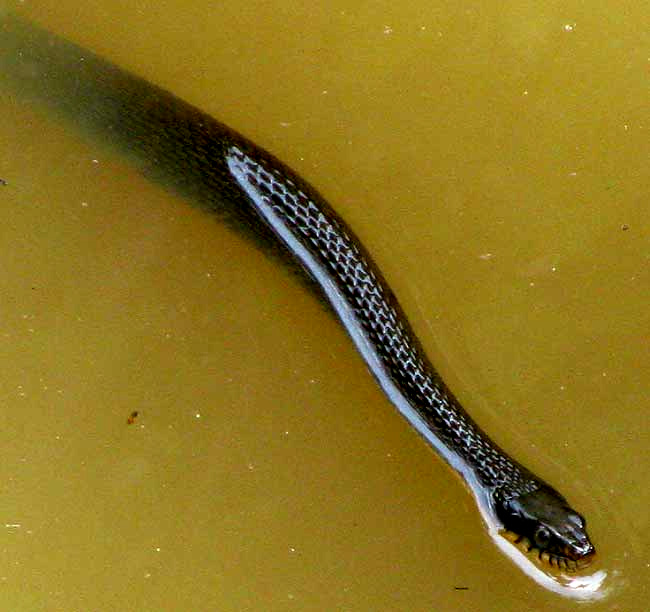Excerpts from Jim Conrad's
Naturalist Newsletter

from the May 13, 2012 Newsletter issued from the woods of the Loess Hill Region a few miles east of Natchez, Mississippi, USA
YELLOW-BELLIED WATER SNAKE
At midmorning a young, two-ft-long (60cm) water snake rose to the surface of a muddy-watered drainage ditch running beneath a little bridge on an isolated gravel road. Above you can see how the snake kept most of his body underwater but poked his head high enough above the water's surface to see all around.
With round pupils, smallish head and narrow neck he's obviously not a venomous cottonmouth. Since he snake looks so at home in the water and he's covered with "keeled scales," it's a good guess that he's a water snake. Keeled scales are those with their upper surfaces bearing low ridges. Notice how each diamond-shaped scale is shadowed on one side and bright on the other. It's the elevated keels making the shadows. Water snake scales are heavily keeled, probably to help the snakes gain better purchase on the water as they wiggle through it.
In the field guide, our snake's cream-yellow bottom and black lines radiating from the eye to the mouth matches the Yellow-bellied Water Snake, NERODIA ERYTHROGASTER spp. FLAVIGASTER, a mostly Southeastern US species. The species' basic colors change throughout its distribution, so from Delaware to northern Florida and southeast Alabama it displays a red, orange or pink belly and is called the Red-bellied Water Snake. Elsewhere there's the Copper-bellied Water Snake and the Blotched -- all intergrading subspecies of the same Nerodia erythrogaster. Our yellow-bellied subspecies occurs from north-central Georgia to eastern Texas and up the Mississippi to southwestern Illinois.
The Audubon guide says that Yellow-bellied Water Snakes are active in early evenings, but this one was a morning snake. I read that they sleep high in branches of trees overhanging streams, and have been seen anchoring themselves in stream vegetation, keeping their mouths opened to the current, grabbing any small fish that happen by. They also eat frogs and tadpoles. Our Yellow-bellied calmly and systematically swam along both banks of the drainage ditch eyeing where frogs might be.